The UK E-commerce Industry: Everything You Need To Know
Guides
1. Introduction
The UK e-commerce industry is a rapidly growing sector, with a revenue of £2,089.6 billion[1]. According to reports, the sales from online retail account for over 30% of total retail sales[2] in the UK.
Over time, digital commerce in the United Kingdom is expected to expand even further. So, how do you exploit this market’s potential?
You’ll need to keep up with the latest trends in the country’s e-commerce, top platforms and carriers to partner with, insider tips, and more.
To help you with this, let’s dive into the trends influencing English online retail.
2. Trends in UK’s E-commerce Market
With the growing demand for convenience, the focus of online retail is slowly changing. Here are the top trends at the forefront of the evolving British e-commerce market:
a. Omnichannel is growing in preference
Online and offline shopping are no longer separate but effectively one continuous experience. There are different ways to explain this. For starters, many buyers today walk into retail stores having done their homework. According to a report, consumers looking for inspiration and product information usually start their shopping journey with search engines. That’s at least 42% of shoppers in the UK[3].
Shoppers that do browse through offline stores are there to experience the quality, fit, feel, and features of the products there. Some may take pictures or note styles and product codes to research these products in detail online until they are ready to buy them.
These behaviors have given rise to –
- Buy online, pickup in-store (BOPIS): Based on a Statista Global Consumer Survey[4], 45% of the respondents from the UK prefer picking up online purchases from offline stores. This concept gained popularity during the pandemic and is expected to continue in the coming years given the convenience it offers.
- Buy in-store, ship to home: 39% of consumers appreciate the option to buy offline and have their purchases delivered to their homes.
- Buy online, return in-store: 41% of consumers choose to return purchases bought online through offline stores.
- Consumers love the convenience provided by omnichannel retail. It offers them flexibility, allows them to experience products before buying, and receive a humanized return experience.
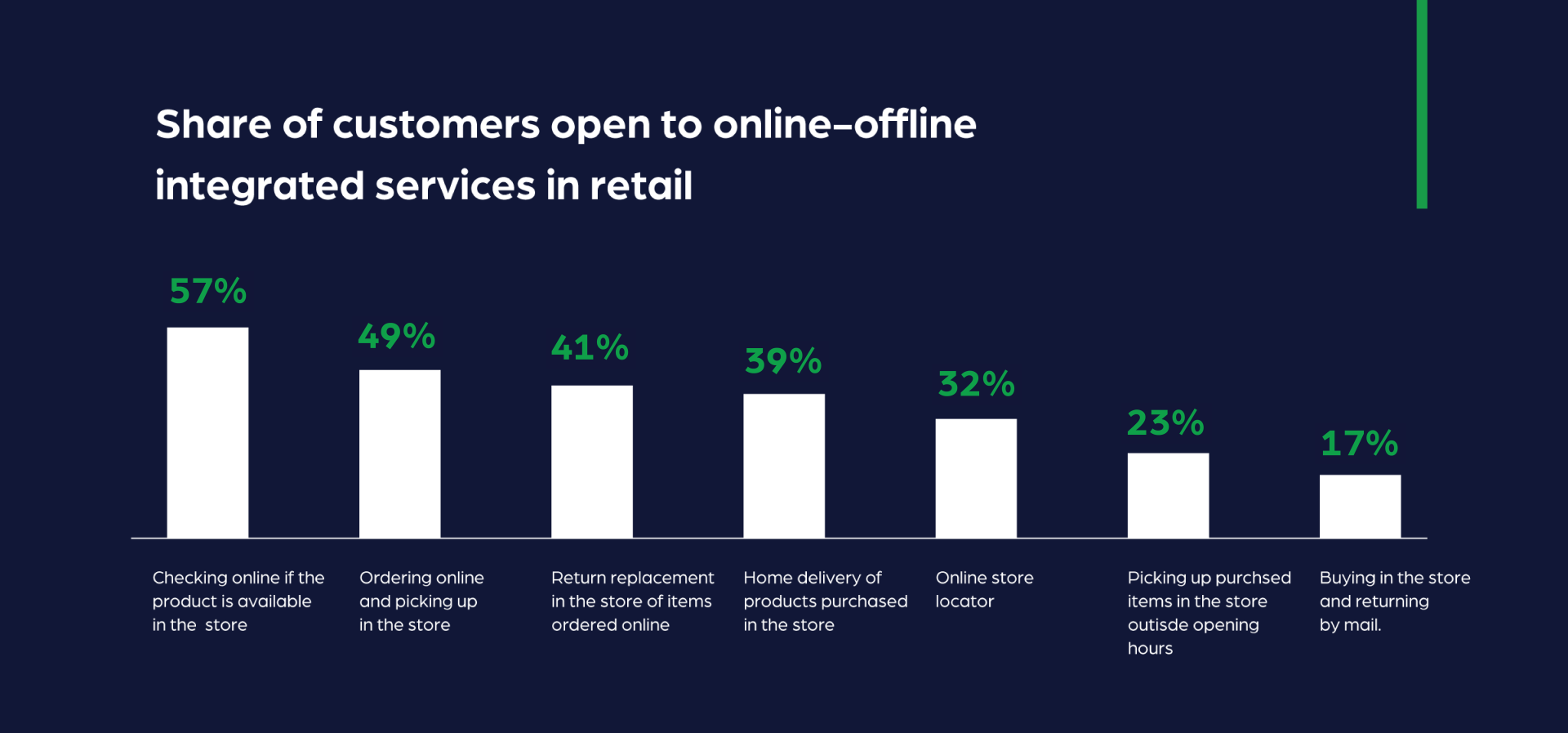
Source: Statista
b. Social commerce is popular
A study[5] claims that social media’s role in the UK’s retail growth is booming. In the first quarter of the year, 32% of the respondents in the study claimed they’d purchased an item after seeing it on social media. Out of these individuals, half of them did it directly from the social platform.
The study also reveals that among Gen Z, Instagram (53%) and TikTok (41%) are the most popular social media platforms for shopping and for Millennials, Instagram (52%) and Facebook (49%) are the most popular.
Social Media is not only an increasingly important sales channel, but social media ads are also a highly impactful way to engage consumers and trigger them to spend. Facebook ads are currently used by brands to redirect platform users to their websites selling fashion, apparel, shoes, accessories, beauty products, and more.
c. Subscription e-commerce is booming
Subscription e-commerce is another form of retail that’s picking up in the UK. It is a business model that allows customers to pay a recurring fee to receive specific products on a regular basis. For example, pharmaceutical products, groceries, household items like soaps,
Research shows that households in the UK spent €742.7 per year[6] on subscriptions in 2021. That makes the average spending on subscriptions per month approximately €62.3. The subscription box shoppers stayed signed up for an average of 9 months, which is a big step toward growth for this segment.
When it comes to subscription box items, food is the most popular category, followed by shaving products, clothing, perfume and cosmetics, and pet products.
d. Fashion, cosmetics, electronics, and pharmaceuticals are hot categories
In the UK the most popular categories for online purchases[7] include:
- Fashion – Clothing (57%), Shoes (37%), Bags & accessories (27%)
- Cosmetics & body care (29%)
- Consumer electronics (24%)
- Pharmaceuticals (23%)
“Selling apparel and fashion is immensely popular in the UK e-commerce industry. Clothing is available in perfect sizes, and it is cheap to ship as there is no real challenge in moving these items. Any carrier can do it at a competitive rate. The growing interest in fast fashion is also adding to the popularity of this online retail segment,” says Claire Porter, Senior Business Development Manager at Anchanto UK.
Online cosmetics, electronics, and pharmaceuticals are also gaining popularity as online retailers typically offer a wider range of products. Digital platforms often provide detailed product specifications, customer reviews, and recommendations, helping customers make informed purchasing decisions.

3. Top E-commerce Marketplaces in the UK
Managing a multi-channel presence is essential for businesses selling in the UK e-commerce industry to reach their target audiences. Here are some of the trending online marketplaces preferred by shoppers in the country:
- Amazon: Amazon.co.uk is a leading online marketplace in England. Around 86%[8] of people in the country shop on this platform. About 70% of people in the UK shop on Amazon at least once a month, while 17% use the online marketplace weekly. The marketplace receives an average of 374.2 million monthly visits[9].
- eBay: In the UK, eBay has over 22 million active users[10] and is ranked among the top 10 websites in the country, when it comes to traffic. The marketplace allows the sale of various products and offers a Global Shipping Program that makes international postage simple.
- Etsy: Etsy United Kingdom is a marketplace for handmade gifts, vintage and on-trend clothes, unique jewelry, and more. Top-selling product categories on this platform include jewelry and home décor. Etsy offers sellers a variety of tools to grow brands on the marketplace.
- OnBuy: OnBuy is one of Europe’s fastest-growing e-commerce platforms. The online marketplace has over 6 million customers[11]. The marketplace receives 3.4 million monthly visits on average and has grown popular over the years in the UK.
4. Top Last-Mile Carriers in the UK
To get your products to buyers, it is essential to work with a reliable delivery network. For last-mile delivery, these are some of the ideal companies to partner with.
- DPD: Powered with innovative technology and knowledge about the local scenario, DPD offers delivery services across the region. They have a network of 58,000+ pickup points and 97,000+ delivery experts delivering 7.5 million parcels every single day. Their aim is to offer sustainable deliveries to enable e-commerce growth and ensure customers have constant access to their parcel status.
- HubEurope: Shipping solutions provider, HubEurope, offers tailored shipping solutions across the local and international market. They sync with online stores to streamline order processing, real-time tracking, and shipping label generation.
- Amazon Shipping: Amazon Shipping helps businesses get their parcels delivered directly to their customers. Once an order is placed, the seller can create a shipment on Amazon Shipping, to initiate delivery. Additionally, the platform enables efficient parcel tracking.
- Royal Mail: The UK’s Royal Mail is a multinational postal service and courier company. It offers a variety of parcel delivery options for businesses. This includes next-day delivery, urgent same-day delivery, 24 to 48-hour delivery, and more.
- Courier API: Courier API allows businesses to integrate with 75+ international couriers through a single shipping API. This allows users to manage domestic and international couriers in one place, with the flexibility to operate services globally.
- Evri: This leading parcel and delivery company focuses on giving responsible delivery options for personal as well as business requirements. Their services (domestic and international) allow customers to send, receive, and return parcels. Evri Corporate currently has a team of 18,000+ couriers, 8500+ local parcel shops, and a growing network of hubs and depots.

5. The UK’s E-commerce Industry Challenges
Even though the e-commerce industry in the UK is growing continuously, certain challenges must be overcome to reap market benefits. For the United Kingdom, these hurdles are most prominent:
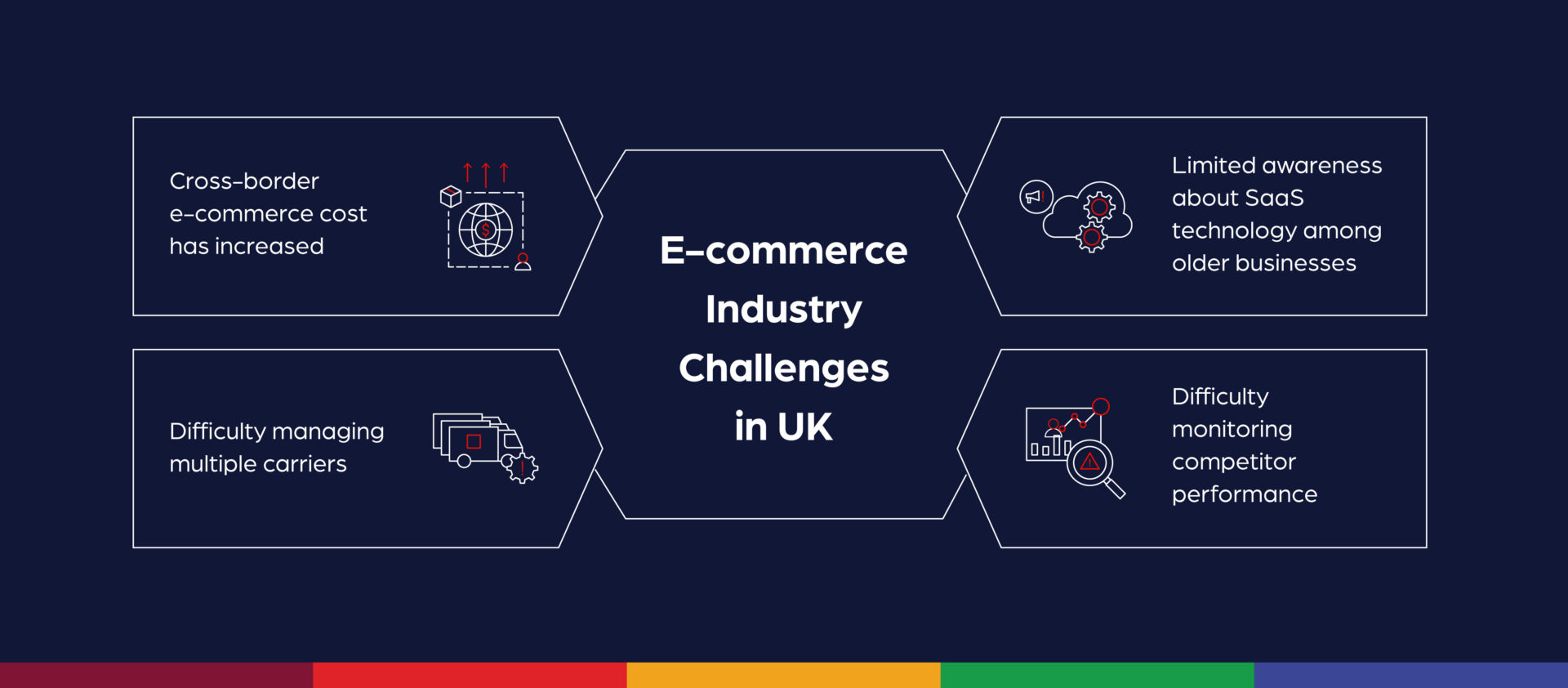
a. Difficulty managing post purchase experience
Sometimes, high-value items may require specialized or express shipping options and low-value items require standard shipping options. As a result, businesses may use different carriers because each one has a different service offering. This may also be the result of cross-border e-commerce. For example, if a business in the UK is selling to a cutomer in Spain, they may use different carriers to transport their products from the UK to Spain and from the sorting center to the end consumer.
However, managing these different shipping partners can become challenging without the right means. Moreover, tracking parcel statues, delays, and delivery estimates will be different for each shipping partner. So, monitoring these details and assessing data from each partner will require dedicated resources.
“We found it difficult to absorb multiple tracking events and extract information in the quantity we wanted. We were missing a robust platform capable of managing millions of tracking events. Better tracking ensure better interaction with shoppers and improve their experience.” says Lionel Berthe, Head of Asia-Pacific, Asendia.
b. Limited scalability due to outdated technology
Many established businesses in e-commerce and logistics in the UK use custom-built technology to manage their operations. Unfortunately, these systems are unscalable, complicated, and costly to upgrade, update, and add onto. For example, if a retailer uses multiple carriers, a new integration is required for each carrier. This is expensive and so is maintaining custom-built integrations.
Newer businesses in e-commerce and logistics are more aware of SaaS technology to manage their inventory and orders. But, identifying the best technology with dynamic, scalable integrations can be difficult.
c. Difficulty monitoring competitor performance
The e-commerce market in the UK is highly competitive, which can make it challenging to penetrate. There were 580,000 e-commerce-enabled websites[12] recorded in the UK in the past year and this number is growing. Besides this, there are several retail businesses registered on marketplaces striving for customer attention.
With thousands of local and foreign businesses doing online retail in the country, tracking competition to identify a way into the market can be tough. A lack of real-time data on competitor products, pricing, promotions, and customer response makes it difficult to see weak links or opportunities to stand out in the competitive market.
d. Cross-border e-commerce costs have increased
To trade across borders in the EU and beyond, businesses in the UK need to pay certain tariffs. These tariffs and taxes have increased in recent years for cross-border e-commerce transactions and UK sellers are finding it more difficult to compete with EU sellers.
UK imports from the EU are now liable for VAT. The low-value VAT threshold has been removed[13] for goods coming into the UK. The EU has implemented similar measures. So, if a business ships a product from the UK to a customer in Spain, they need to pay customs duty and taxes.
“Doing cross-border e-commerce requires strict documentation, identifying taxes, parcel checking across borders, and harmonization codes. To overcome these challenges, some businesses are setting up fulfillment centers in different countries across the EU,” claims Claire.
6. Tips to Succeed and Scale in the UK E-commerce Industry
If you are an e-commerce business looking to thrive in the UK market, there are a few key tips you should keep in mind. From personalization to faster delivery, there are different strategies you can use to differentiate your brand, attract, and retain customers, and then drive revenue growth.
This section covers top tips to navigate the ever-changing e-commerce landscape in the UK. Keep reading to see how you can incorporate them into your business:

a. Personalization through data
Consumers are interested in personalized shopping experiences and brands that provide this are rewarded for their effort. A report states[14] that there’s a 60% increase in U.K. consumers who feel frustrated with a brand whose personalization initiatives don’t recognize their unique desires and needs. According to a McKinsey & Company study[15], brands that offer exceptional personalization see 40% more revenue compared to those that do not.
To deliver personalized experiences, collecting consumer data is vital. You can collect this information through digital shelf health assessment and compare your findings to your competitor’s. Based on consumer responses, you can determine how to personalize your promotions, pricing, product messaging, kits and bundles, and more.
Similarly, shooting personalized communications about products ordered and their fulfillment progress can attract customer loyalty and positive word of mouth.
b. Explore social commerce
While millennials have found value in social media e-commerce, the younger generation, Gen Z, is leading the way when it comes to shopping via this channel. However, social commerce is still in its infancy. This makes it an ideal channel to explore. Competition across this sales platform will also be low and you can experiment with different concepts and ideas to attract customers.
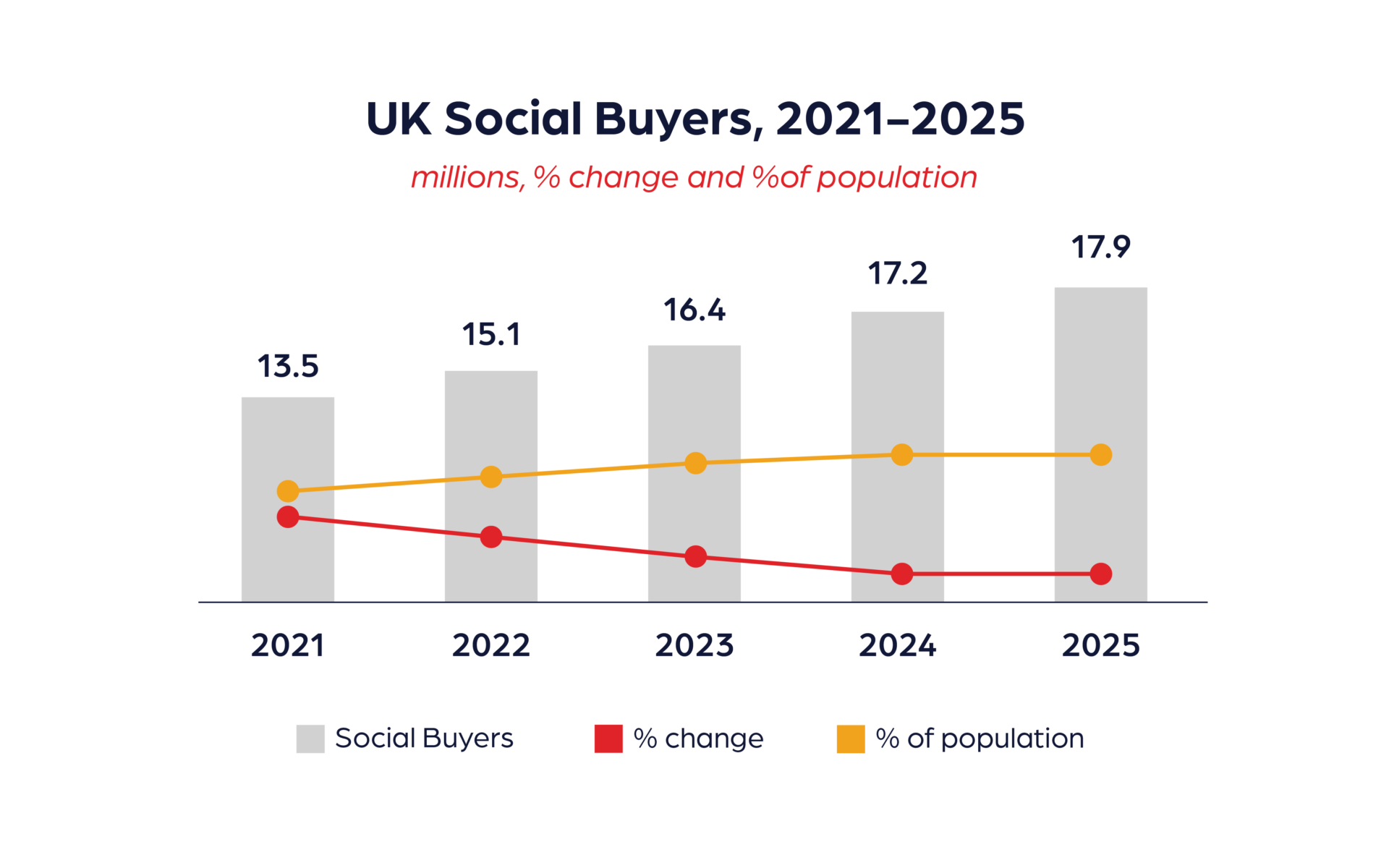
Source: eMarketer[16]
c. Offer omnichannel experiences
Consider selling through multiple channels including offline stores. With a brick-and-mortar outlet, you can try different omnichannel strategies that personalize your offerings and allow you to interact with customers.
If an offline setup is beyond budget, consider partnering with offline businesses. For example, as a brand you can strike a deal with offline retailers, distributors, and e-commerce enablers to carry your products in their offline store. You could also form an offline network with local stores like supermarkets for consumers to come to pick up online purchases from your brand.
Luxasia is an omnichannel beauty and cosmetics leader in SEA, Taiwan, and Hong Kong with over 2,000 retail touchpoints across 11 countries. The company works with renowned brands like Hermès, Loewe, Paco Rabanne, and Calvin Klein, and takes great pride in offering exceptional services. However, given its large-scale omnichannel operations, Luxasia experienced limited control and visibility over sales channels, operational errors, and restricted growth.
To manage its multichannel retail, Luxasia implemented Order Management Software that didn’t involve any change in their warehousing, staff, SAP implementation, or investing a single dollar in hard assets. The result of using an advanced Order Management was 7X growth in terms of orders, SKU’s, and revenue for all of Luxasia’s brands and it also fulfilled its ambition of running seamless operations in its target regions in just 1 year.
d. Use scalable technology
Managing your e-commerce orders, inventory, catalogs, promotions, omnichannel strategy, and fulfillment needs can be a tedious task with a multichannel presence. And as you grow your business, it gets even tougher. To ensure your e-commerce operations are running smoothly, implementing technology is crucial.
Through scalable technology platforms you can grow your business as much as you like without backend restrictions. You also receive complete control and visibility over operations allowing you to function from across borders, districts, and sales channels without investing in too many resources.
Also, select technology that integrates with your existing e-commerce ecosystem and systems (for example, SAP, QuickBooks, etc.) to uncomplicate your processes.
As a brand, retailer, distributor, or e-commerce enabler, look for technology that can monitor your digital health, control catalog distribution, third-party and grey seller management, and proactively suggest action plans for improved customer experience and sales.
When choosing a 3PL, 4PL, or logistics provider ensure they use technology that provides centralized parcel and carrier management, scalability, additional services, and delivers accurate real-time customer reporting.
e. Optimize delivery
Choose partners that help you stay competitive as these are likely to prevent delayed deliveries.
More than 50% of people in the UK[17] consider same-day delivery as “important,” and over 60% expect next-day delivery options. This makes fast delivery a top requirement when purchasing anything online.
Fortunately, you do not have to overspend on expedited shipping as there are many 3PL fulfillment options within the country. You just need to choose the best based on the delivery rate across your target locations in the UK.
Also, check if your 3PL or delivery partner in the UK can provide flexible last-mile delivery options. This can include pick-up and drop-off (PUDO), buy online pick up offline, curbside pick-ups, parcel lockers, etc. While you don’t have to offer all of this, it is good to consider these to enhance your delivery strategy based on your customers’ needs.
An added benefit is a 3PL or delivery partner with robust technology. This will ensure you receive timely updates on deliveries and returns.
“We have a robust platform to manage millions of tracking events, onboard multiple suppliers with ease, and offer better services to our clients. This technology also enables us to have better relationships when tracking products and be interactive with our clients’ customers to improve the delivery experience,” says Asendia, the international e-commerce and mail delivery solutions provider.
7. Advantages of Cross-Border Expansion
If you are thinking of expanding into the UK, it is vital to know their potential for your business. To help you with this, here are a few things to bear in mind:
Benefits of Venturing into the UK E-commerce Industry
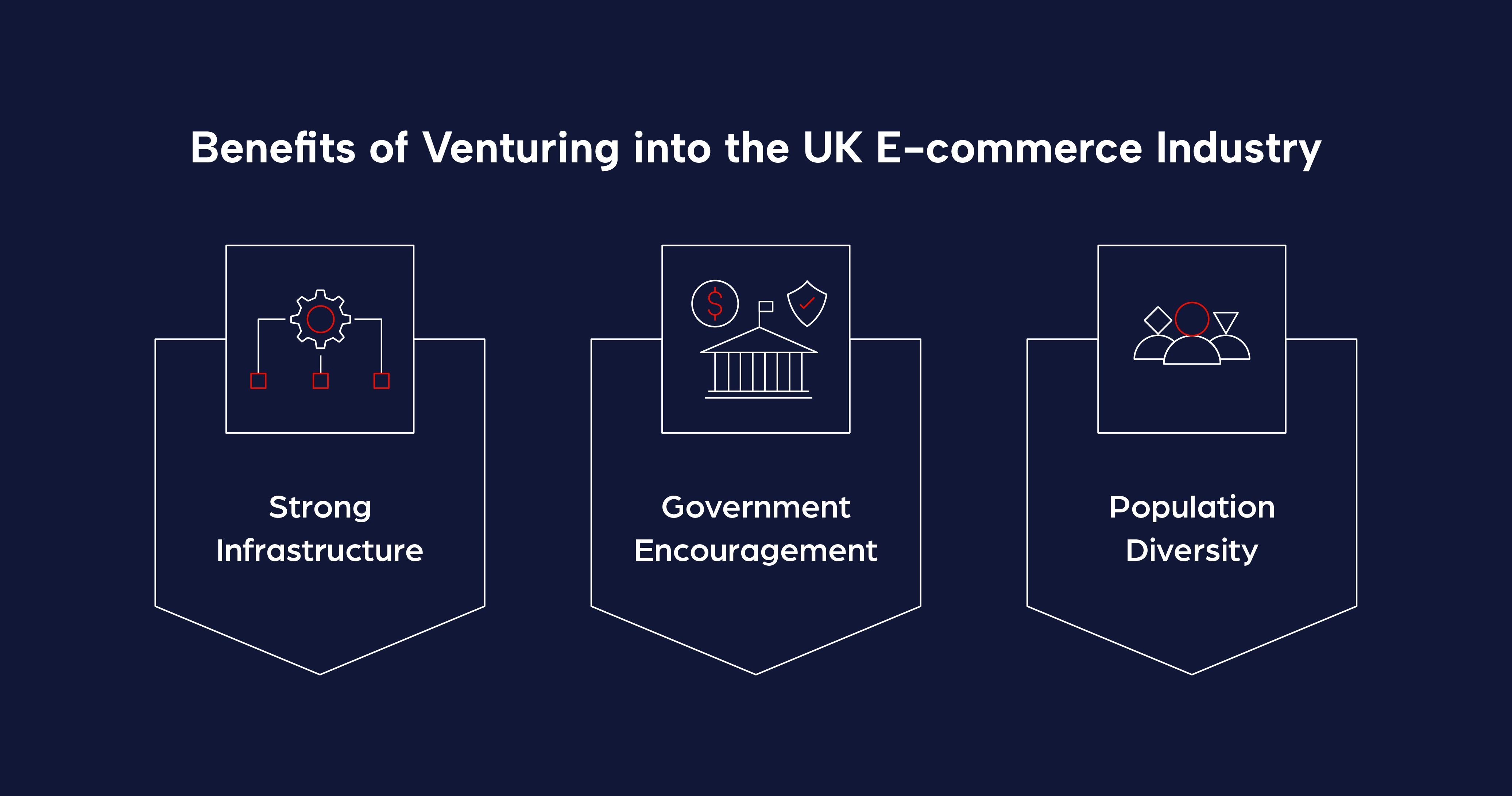
a. Strong infrastructure
The UK has a well-developed logistics and transportation infrastructure, which makes it easier for e-commerce businesses to ship products quickly and efficiently to customers. Their reliable delivery and distribution systems also make it easier and more cost-effective to deliver products to customers. The technology infrastructure supporting businesses here is significant too. These technology platforms are modular, innovative, and integrative with all the key aspects of your e-commerce ecosystem.
b. Government encouragement
The UK government has developed a comprehensive strategy to encourage businesses to trade with the UK. For example, they have established 8 new Freeports[18], which are designated areas with special customs and tax rules designed to attract investment and boost trade. These Freeports offer benefits such as simplified customs procedures, tax breaks, and streamlined planning processes. The government has also implemented measures such as investment in digital infrastructure, support for digital skills development, and the establishment of a new Digital Markets Unit to promote competition in digital markets.
c. Population diversity
The diverse population in the UK offers foreign businesses the opportunity to reach a wide range of consumers with diverse cultural backgrounds and languages. Here’s an image to show you the percentage of the population from other countries in the UK.
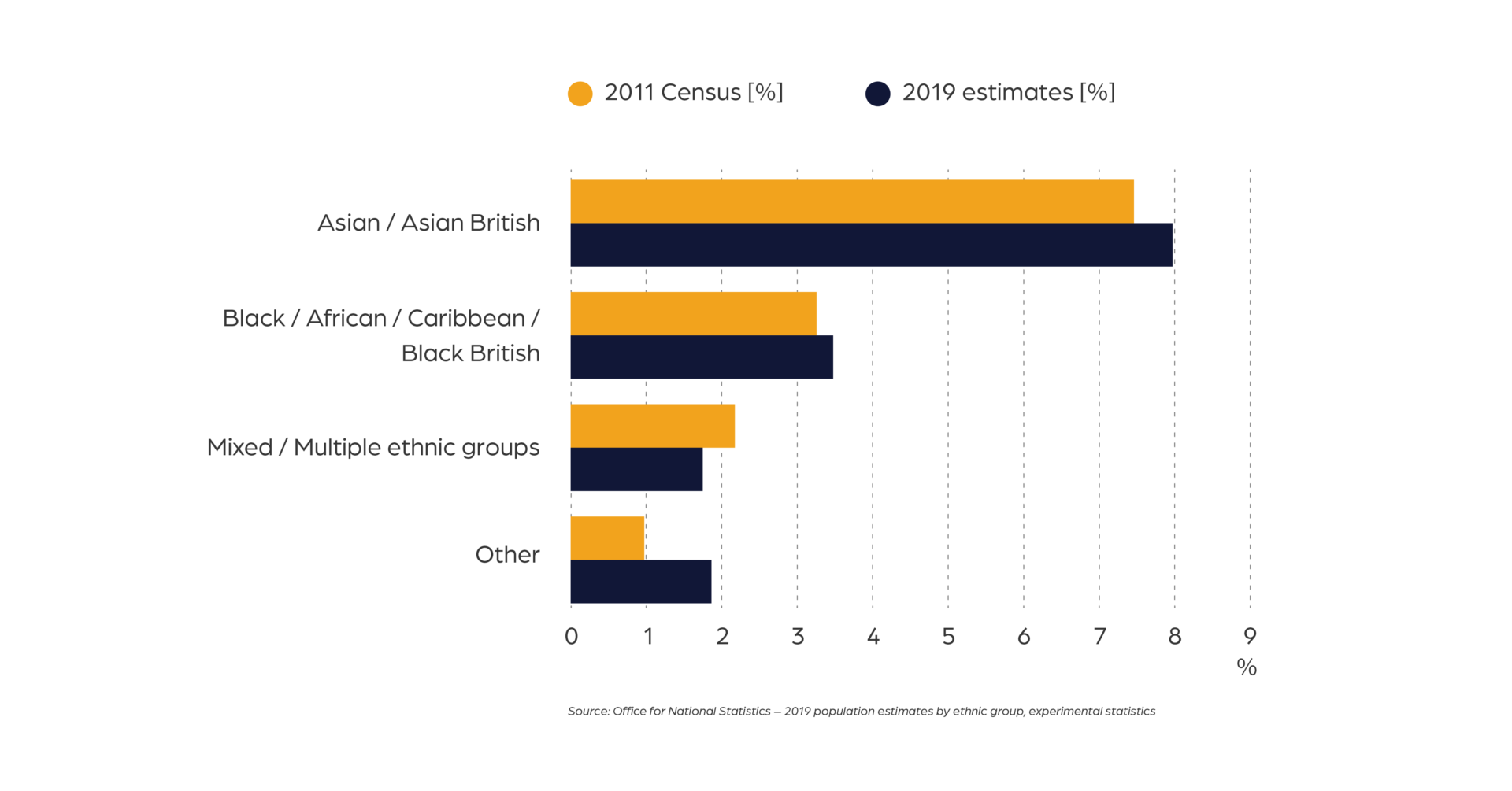
Source: Office for National Statistics[19]
As more people move to the UK for better prospects, these percentages will increase and so will the market for foreign businesses catering to this demographic. For example, the Asian population in the UK will serve as a good market for spices, herbs, and other commodities available in Asian countries.
Benefits of Venturing into Foreign Online Markets for UK Businesses
a. Access to new markets with technology partners
Working with an e-commerce technology company that integrates with local and international marketplaces can be your gateway to foreign markets. You can use their connection with trusted international e-commerce marketplaces, 3PLs, and other partners to sell your products across different markets with ease.
b. Availability of markets in proximity
There are several markets that are fairly close to the UK, which means there are several similarities when it comes to culture. The proximity also reduces logistics costs and increases the opportunity to try more markets.
c. New ideas and concepts
E-commerce in the UK has advanced significantly over the years and the same is true for the markets in neighboring countries. While most regions may follow universal e-commerce practices, there’s a lot to learn from them. Experiencing the Asian, Australian, or European e-commerce markets can introduce your business to interesting concepts and ideas that you can enhance further.
8. It’s Time to Prepare
In this article, we’ve covered the major aspects of the UK e-commerce industry, including current trends, e-commerce marketplaces, last-mile carriers, industry challenges, and more. We’ve even covered tips for success in the UK.
With this information, you can take your research further to understand your target market and the customers within it. At the same time, remember to:
- Develop partnerships and leverage partner knowledge on the local market
- Be aware of the market-specific challenges
- Leverage omnichannel retail to enhance shopping experiences
- Use e-commerce technology to simplify cross-border and multi-channel selling
Want to expand your brand internationally?
Reach out to one of our e-commerce experts to get answers to all your questions.
References – 1, 2, 3, 4, 5, 6, 7, 8, 9, 10, 11, 12, 13, 14, 15, 16, 17, 18, 19

